Optimization of your Joomla hosted website is vital for two very important reasons: a) you’ll attract and retain more visitors, and b) it will perform better in search engines. Both of these together vastly increase your chances of engaging a much wider audience.
It doesn’t take a great deal of effort to optimize Joomla. In fact, many methods take nothing more than a few clicks of the mouse. Others simply rely on changing how you manage multimedia.
If you use any of the possible ways to make money from your site, optimization is a key element. Every person who comes in and spends any significant time browsing your content has potential to increase your income. Because of this, you need to provide the best experience possible.
In this Joomla performance tutorial, I’m going to cover eight ways you can improve the efficiency of your site. Some of these take very little time to implement, but all of them deliver a better way to engage the visitors.
1. Keep Everything Updated
Keeping everything up-to-date will ensure the platform stays stable and optimal. Part of this is because developers will often fine-tune their own code to make the plugin or module more efficient. Sometimes this will include adapting to new technology, such as the conversion to responsive design for mobile devices.
If a new version of Joomla or its extensions has been detected by your website, a message will appear in the Control Panel. Look down under the Maintenance section to access any of these updates. You can also manually check for upgrades to Joomla or any of its pieces from this area.
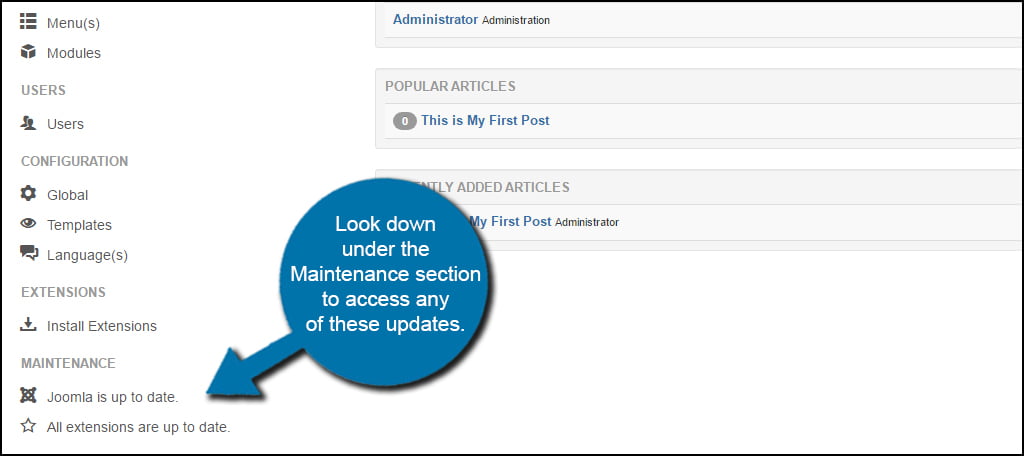
2. Enable Caching in Joomla
Caching is essentially creating a kind of copy of your site that visitors access. It reduces the time in which browsers load various resources such as data and images. Depending on the size of your pages, this could save a great amount of time for humans and search engine bots alike.
To enable caching, click the “Global” link under the Configuration heading in Control Panel.
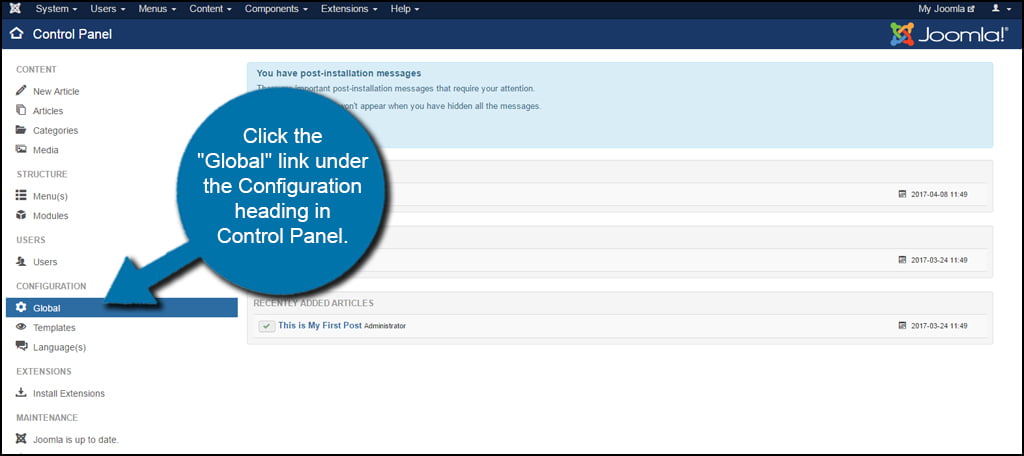
Click on the “System” tab along the top.
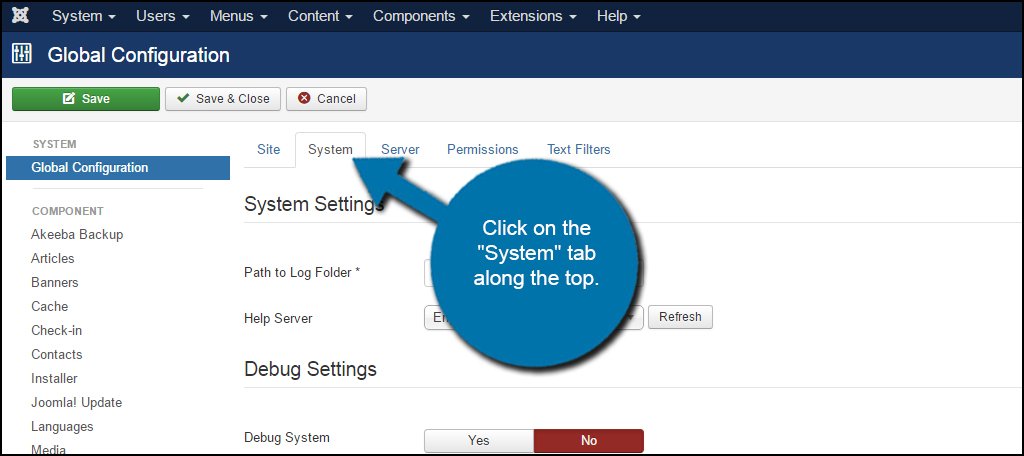
Scroll down to the Cache Settings drop-down box and select “Conservative caching.” Using the progressive options saves a cache for each individual user that comes to the website. Unless you absolutely need it, I suggest remaining with conservative caching for the best performance.
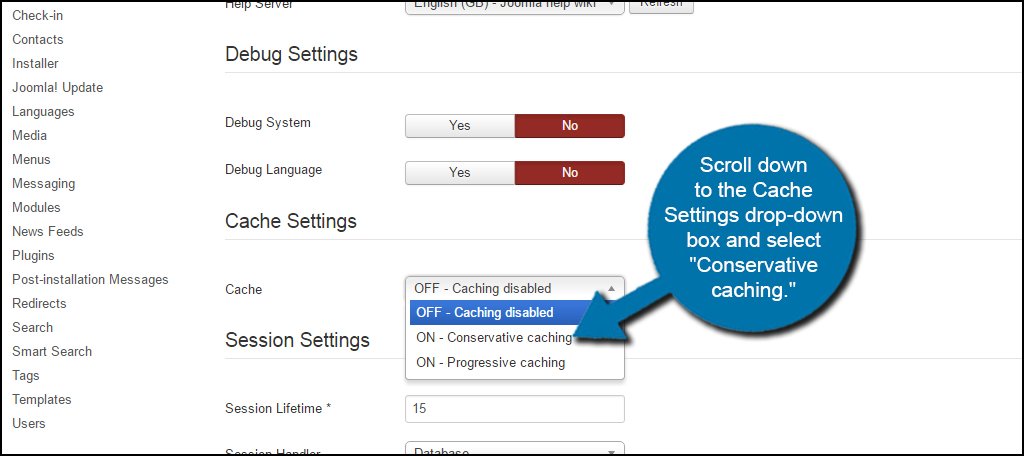
Leave the settings that appear under Conservative caching as their defaults for now. You can modify these later should you need. For now, scroll back up to the top and click the “Save & Close” button.
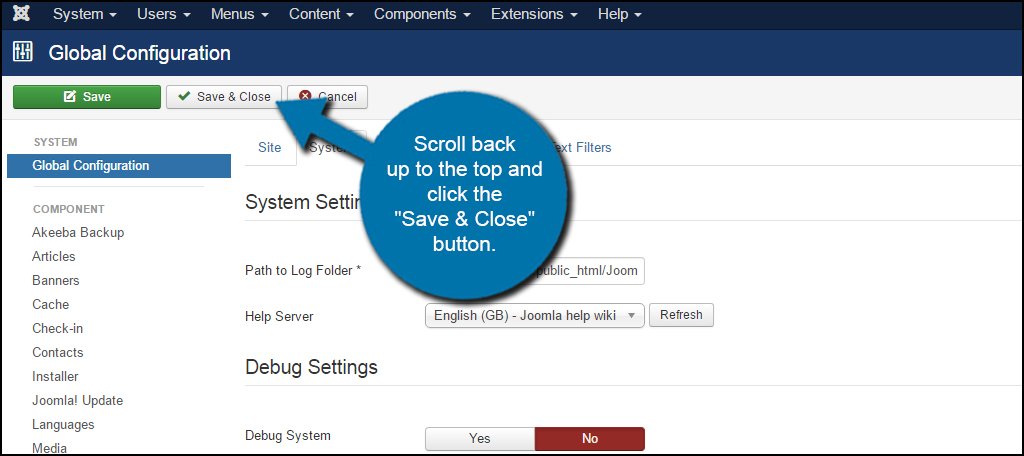
Go to the Extensions option across the top tool bar and click “Plugins.” We need to activate page caching for Joomla.
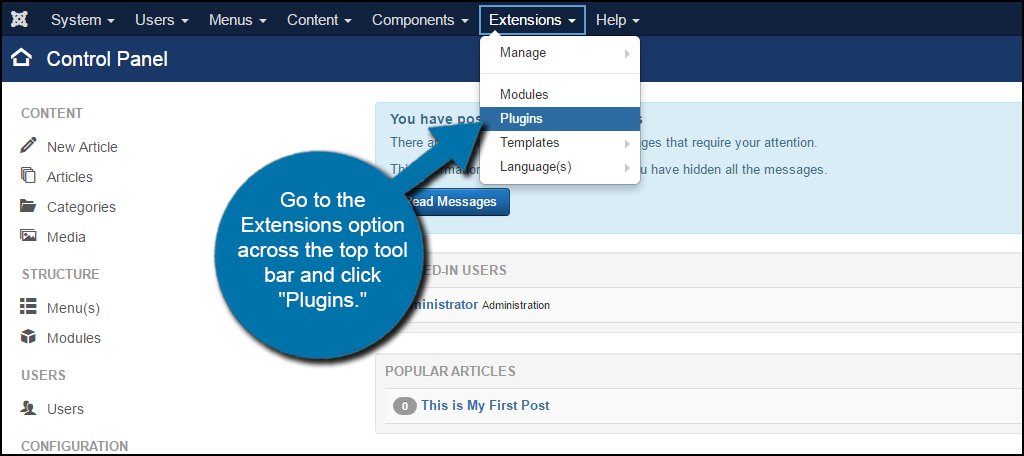
Search for the plugin by typing in “Cache” and hit enter or the search button.
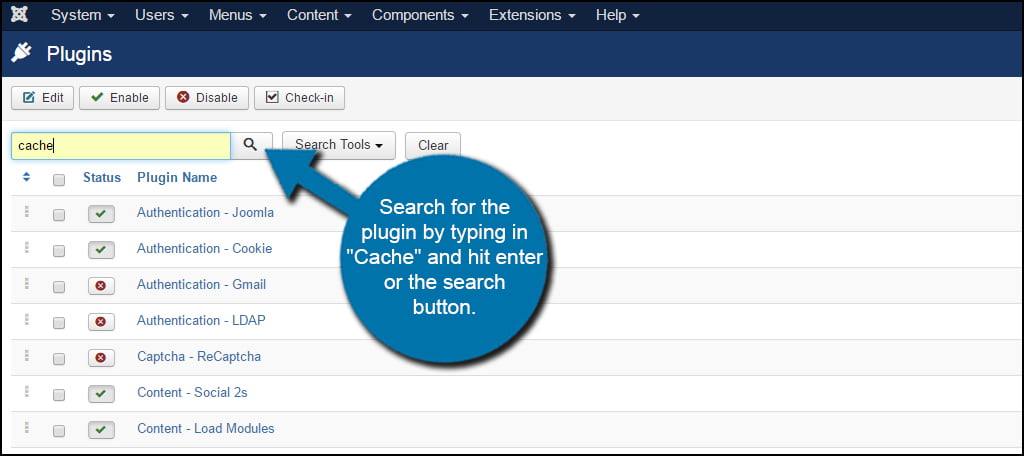
Click on the red circle with a white “X” to enable the “System – Page Cache” plugin.
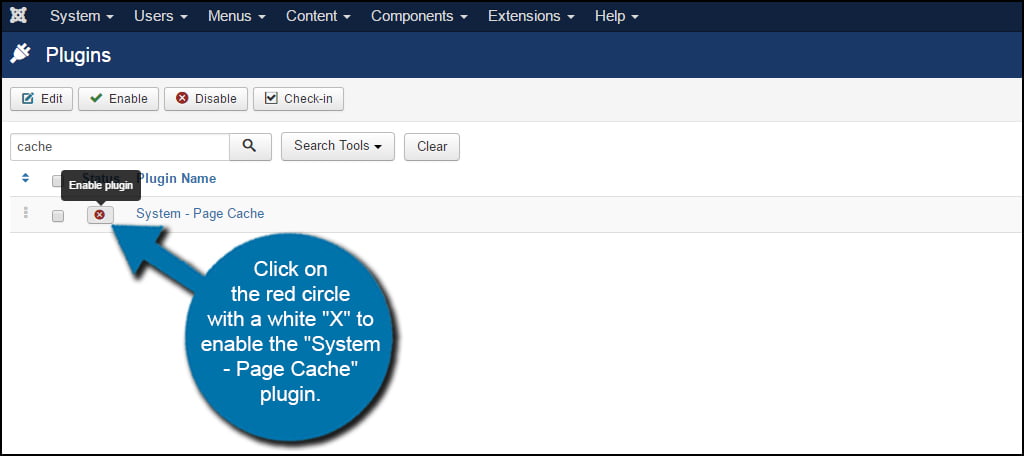
3. Enable GZIP Compression
Compression essentially shrinks the website as it is downloaded to a visitor. This package then expands into the user’s browser.
Why is this important? Because it reduces the time it takes to transfer elements of the site and relies more on the visitor’s hardware to render the content. As a result, the site becomes faster.
It’s like zipping up files to make them smaller and then unzipping the to access the content. Only this process happens very quickly.
To enable compression, go back to the Global configuration screen but this time click the “Server” tab.
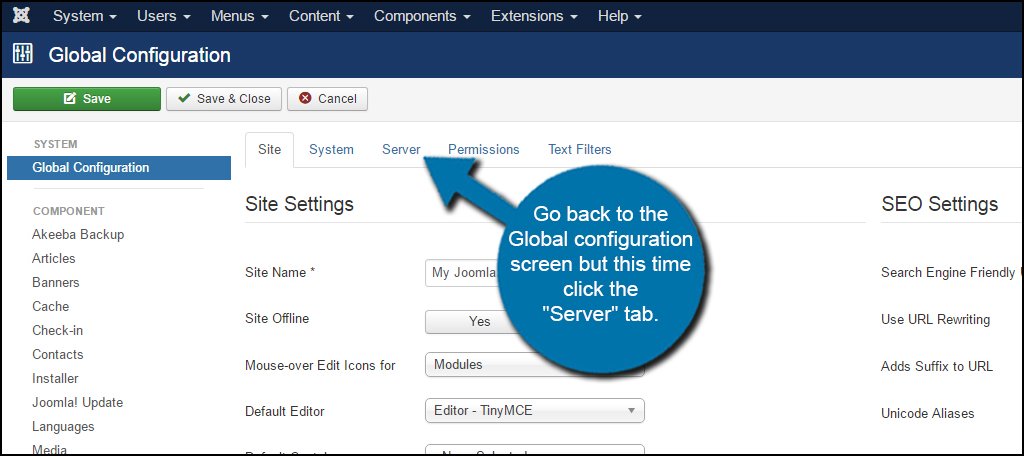
You’ll see an option under “Server Settings” for “Gzip Page Compression.” By default, Joomla has this set to “No.” Click the “Yes” button to enable Gzip Page Compression.
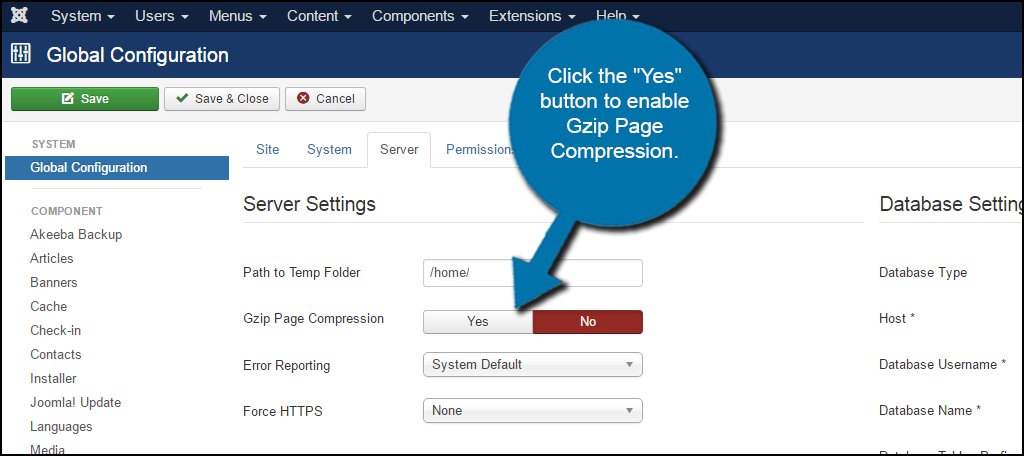
Click the “Save & Close” button when you’re done.
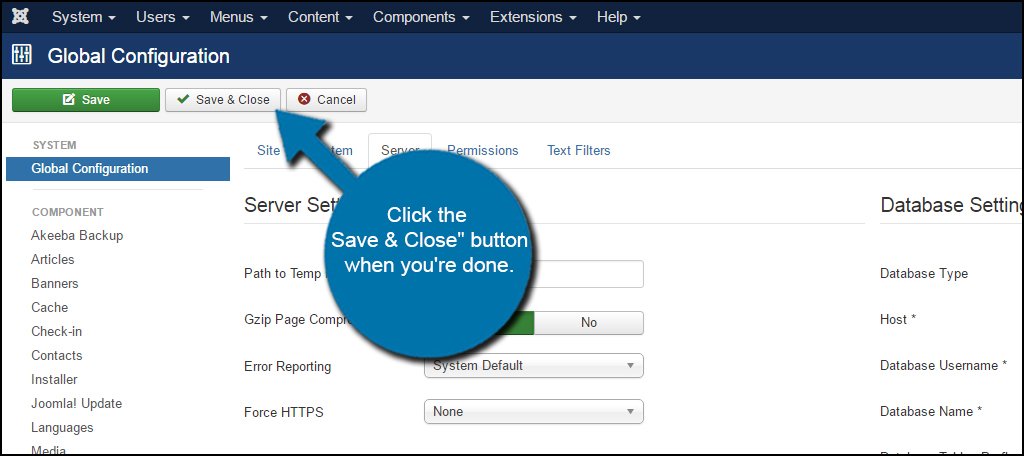
4. Install Optimization Extensions
One of the beautiful things about Joomla is the ability install modules and plugins. You can find optimization extensions at the Joomla Extensions directory or by browsing on the web.
Always be careful when downloading third-party extensions from unknown sources. Research the developer before using their Joomla tools to make sure there are no complaints regarding issues such as malware or broken plugins.
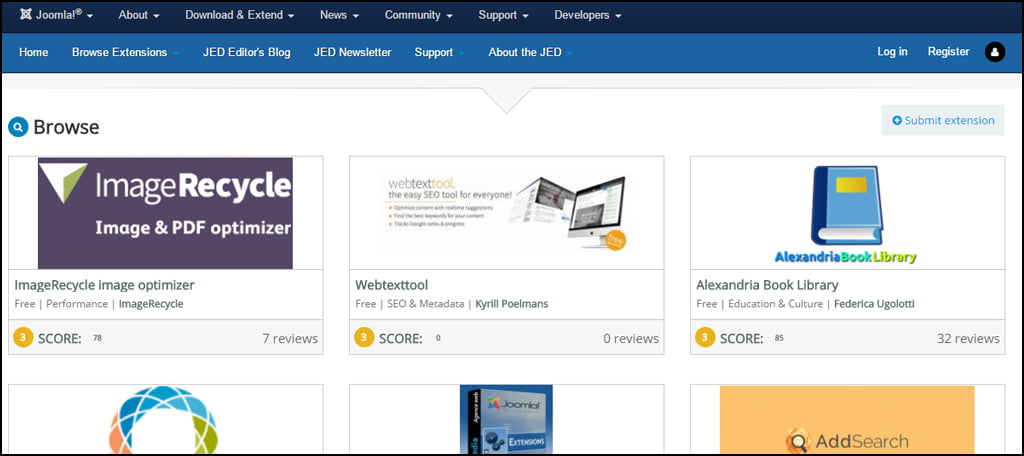
JCH Optimize
The JCH Optimize extension combines JavaScript and CSS files into one. This reduces the amount of HTTP requests the website has to make, thus making it faster.
JotCache
Essentially, JotCache improves the built-in method Joomla has for storing files for later use. It improves the access time of caching for larger websites while including selective use between browser caches and the page.
These are only a couple of the many extensions for optimization you can install. I would suggest spending a bit of time and exploring the directory to find tools that will improve your website.
5. Optimize Image Use
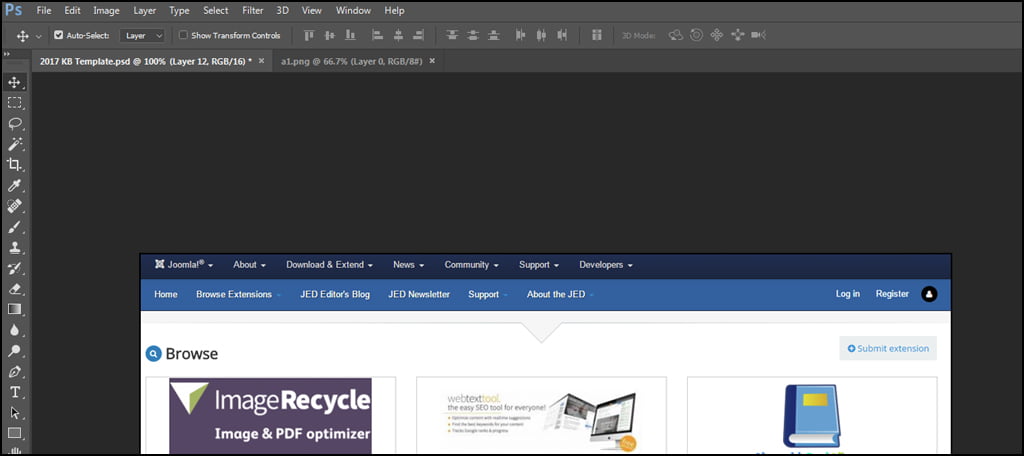
Optimizing images is an excellent way of cutting load time of your website. This is especially true when you consider how much of an impact images make on mobile access. Not everyone has the fastest connection to the Internet, and rendering large graphics takes a great deal of time.
Graphic design apps like Photoshop make image optimization simple. Just by cropping down or reducing image quality can greatly improve Joomla speed.
Some ways to optimize graphic use is to:
- Use the correct size of images.
All too often people will upload graphics that are incredibly large and then make them smaller by changing the width and height in code. However, this doesn’t stop the system from rendering the image in whole first. If you need a 150 by 150 pixel thumbnail, upload a 150 by 150 pixel image. - Reduce the resolution.
In the grand scheme of things, the optimal image resolution for use on the Internet is 72 dpi. Unless you plan on printing the graphic directly from the website, anything beyond 72 is a waste of space as well as bandwidth. - Lazy Load Images.
Lazy loading prevents images from appearing until the visitor absolutely needs them. This can save a ton of bandwidth, especially if you’re making a large webpage filled with informational graphics. Extensions like LLFJ are free and offer nice effects such as fading in as well as excluding bots so search engines can still index the images.
6. Remove Extensions You Don’t Use
Extensions you do not use will impact the performance of Joomla. Whether it’s preventing a problem from exploits because of a lack of updates or still retained within the system memory, keeping an extension that is obsolete is often problematic.
If you have extensions or themes that you absolutely do not use, it’s advisable to remove them as soon as possible. You can remove Joomla extensions by going into the Extensions Manager, select the one you don’t want and click the “Uninstall” button.
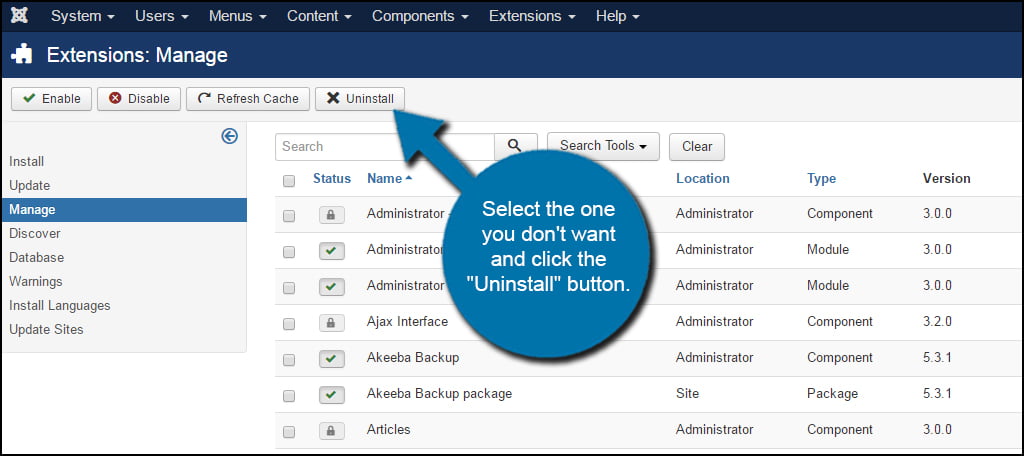
7. Use a Content Delivery Network
Content Delivery Networks, or CDNs, essentially make copies of your site and distribute them around the globe. When a visitor access the content of your site from a nearby server, it improves the speed of your site.
For example. Let’s say you have a CDN server in San Francisco, California and Miami, Florida. A visitor in Georgia will access the site from Miami instead of San Francisco because Florida is much closer.
The CDN is based on the premise of eliminating distance as a factor for speed. This is because a bad point anywhere between you and the website you’re browsing will cause latency and reduce performance, even if the site is the fastest in the world.
You’ll only be as fast as the slowest router or Internet connection along the line between yourself and the site. A CDN reduces the impact of those slow points because there are less of them to travel through.
You can use a free CDN such as CloudFlare on specific hosting plans, but upgrading comes with many other perks such as image optimization and application firewalls.
8. Optimize from .htaccess File
Edits to the .htaccess file can also contribute to improving Joomla speed. By editing a simple code in the file, you can set an expiration date on various site elements. This keeps those components in memory to eliminate the need to load them again if a visitor returns.
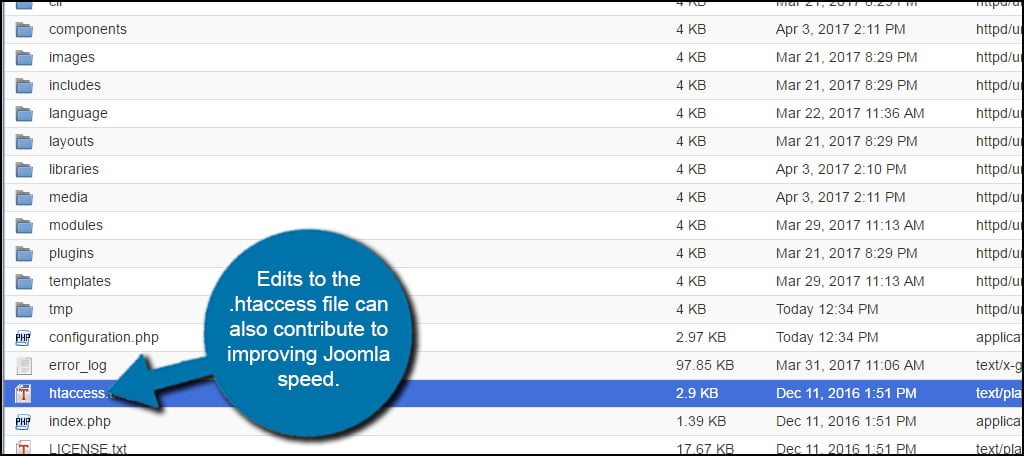
An example of these edits include placing the following in the .htaccess file:
[ht_message mstyle=”info” title=”” ” show_icon=”” id=”” class=”” style=”” ]
ExpiresActive On
ExpiresDefault “access plus 1 year”
[/ht_message]
These edits can be done using FTP programs like FileZilla or through cPanel’s File Manager.
It’s All About Delivering a Good Experience
When you optimize Joomla, you’re making the site easier for visitors and bots to access your content. This improves how others interact with the site and how well your content ranks in search engine queries. Always be on the lookout for more improvements. Anything to shave off even a fraction of a second could lead to profound changes in visitor behavior whether they’re bots or people.
